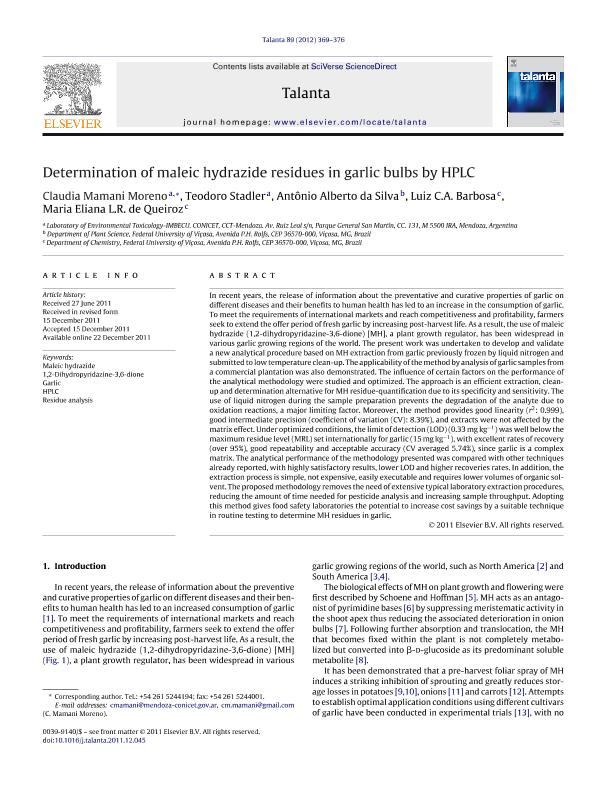Mostrar el registro sencillo del ítem
dc.contributor.author
Mamani Moreno, Claudia Mariela

dc.contributor.author
Stadler, Teodoro

dc.contributor.author
da Silva, Antônio Alberto
dc.contributor.author
Barbosa, Liuz C. A.
dc.contributor.author
de Queiroz, María Eliana L. R.
dc.date.available
2019-07-04T19:00:47Z
dc.date.issued
2012-01
dc.identifier.citation
Mamani Moreno, Claudia Mariela; Stadler, Teodoro; da Silva, Antônio Alberto; Barbosa, Liuz C. A.; de Queiroz, María Eliana L. R.; Determination of maleic hydrazide residues in garlic bulbs by HPLC; Elsevier Science; Talanta; 89; 1-2012; 369-376
dc.identifier.issn
0039-9140
dc.identifier.uri
http://hdl.handle.net/11336/79161
dc.description.abstract
In recent years, the release of information about the preventative and curative properties of garlic on different diseases and their benefits to human health has led to an increase in the consumption of garlic. To meet the requirements of international markets and reach competitiveness and profitability, farmers seek to extend the offer period of fresh garlic by increasing post-harvest life. As a result, the use of maleic hydrazide (1,2-dihydropyridazine-3,6-dione) [MH], a plant growth regulator, has been widespread in various garlic growing regions of the world. The present work was undertaken to develop and validate a new analytical procedure based on MH extraction from garlic previously frozen by liquid nitrogen and submitted to low temperature clean-up. The applicability of the method by analysis of garlic samples from a commercial plantation was also demonstrated. The influence of certain factors on the performance of the analytical methodology were studied and optimized. The approach is an efficient extraction, clean-up and determination alternative for MH residue-quantification due to its specificity and sensitivity. The use of liquid nitrogen during the sample preparation prevents the degradation of the analyte due to oxidation reactions, a major limiting factor. Moreover, the method provides good linearity (r2: 0.999), good intermediate precision (coefficient of variation (CV): 8.39%), and extracts were not affected by the matrix effect. Under optimized conditions, the limit of detection (LOD) (0.33 mg kg-1) was well below the maximum residue level (MRL) set internationally for garlic (15 mg kg-1), with excellent rates of recovery (over 95%), good repeatability and acceptable accuracy (CV averaged 5.74%), since garlic is a complex matrix. The analytical performance of the methodology presented was compared with other techniques already reported, with highly satisfactory results, lower LOD and higher recoveries rates. In addition, the extraction process is simple, not expensive, easily executable and requires lower volumes of organic solvent. The proposed methodology removes the need of extensive typical laboratory extraction procedures, reducing the amount of time needed for pesticide analysis and increasing sample throughput. Adopting this method gives food safety laboratories the potential to increase cost savings by a suitable technique in routine testing to determine MH residues in garlic.
dc.format
application/pdf
dc.language.iso
eng
dc.publisher
Elsevier Science

dc.rights
info:eu-repo/semantics/openAccess
dc.rights.uri
https://creativecommons.org/licenses/by-nc-sa/2.5/ar/
dc.subject
1,2-Dihydropyridazine-3,6-Dione
dc.subject
Garlic
dc.subject
Hplc
dc.subject
Maleic Hydrazide
dc.subject
Residue Analysis
dc.subject.classification
Química Analítica

dc.subject.classification
Ciencias Químicas

dc.subject.classification
CIENCIAS NATURALES Y EXACTAS

dc.title
Determination of maleic hydrazide residues in garlic bulbs by HPLC
dc.type
info:eu-repo/semantics/article
dc.type
info:ar-repo/semantics/artículo
dc.type
info:eu-repo/semantics/publishedVersion
dc.date.updated
2019-06-10T21:22:05Z
dc.journal.volume
89
dc.journal.pagination
369-376
dc.journal.pais
Países Bajos

dc.journal.ciudad
Amsterdam
dc.description.fil
Fil: Mamani Moreno, Claudia Mariela. Consejo Nacional de Investigaciones Científicas y Técnicas. Centro Científico Tecnológico Conicet - Mendoza. Instituto de Medicina y Biología Experimental de Cuyo; Argentina
dc.description.fil
Fil: Stadler, Teodoro. Consejo Nacional de Investigaciones Científicas y Técnicas. Centro Científico Tecnológico Conicet - Mendoza. Instituto de Medicina y Biología Experimental de Cuyo; Argentina
dc.description.fil
Fil: da Silva, Antônio Alberto. Federal University Of Viҫosa; Brasil
dc.description.fil
Fil: Barbosa, Liuz C. A.. Federal University Of Viҫosa; Brasil
dc.description.fil
Fil: de Queiroz, María Eliana L. R.. Federal University Of Viҫosa; Brasil
dc.journal.title
Talanta

dc.relation.alternativeid
info:eu-repo/semantics/altIdentifier/url/http://www.sciencedirect.com/science/article/pii/S0039914011011131
dc.relation.alternativeid
info:eu-repo/semantics/altIdentifier/doi/http://dx.doi.org/10.1016/j.talanta.2011.12.045
Archivos asociados
